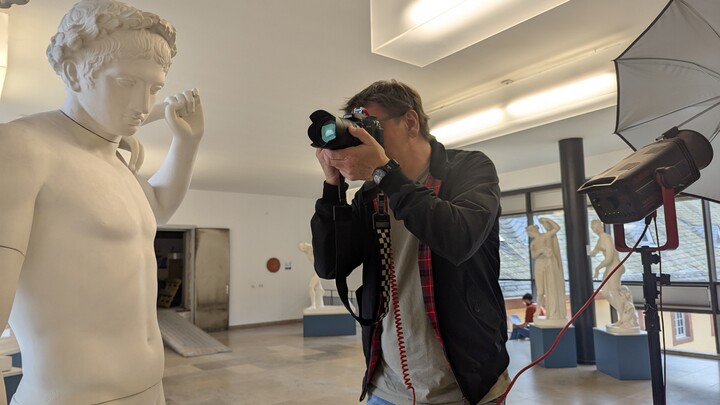Front and Center: Democracy Research at the University of Mannheim

To capture the right images for our theme of “democracy research,” we climbed to the top floor of Mannheim Palace—to the famous Antikensaal. Why? Much like the idea of democracy itself, the statues and busts gathered there point back to antiquity. They’re plaster casts modeled after classical originals, making them the perfect backdrop for the photo collages in this issue. Chipped and a bit dusty, the figures stand silently in place, some missing hands or fingers. With meticulous care, graphic designer Ulrich Ambach brushes off democracy pioneer Solon and his companions—buffing and sprucing them up for their photo shoot.
But what about democracy today? Is it also chipped, dusty, and missing a few limbs? Downstairs in the Schloss, researchers at the University of Mannheim are investigating the current state of democracy. Across all schools, projects are underway that explore the concept from a wide variety of perspectives. The object of inquiry is the same, but the questions and methods are strikingly diverse: How much ambiguity can democracy handle? How much racism lurks in our media? What is the state of free speech in Germany? Are democracy and fundamental rights an inseparable pair? And how far along are New Right movements in building alternative educational systems?
From law to media studies to political science, twelve researchers share their insights in this issue—reporting on final and preliminary findings, survey results that shocked or surprised them, and even projects that didn’t pan out. Democracy is not an easy subject. As democracy researcher Richard Traunmüller aptly puts it, this is “open-heart research.” But see for yourself!
About the Antikensaal in Mannheim
Christian Mann is Professor of Ancient History at the University of Mannheim. His research traces the long arc of Greek and Roman history and explores how its legacies continue to shape society today. In this interview, he explains what the university’s Antikensaal has to do with democracy.

FORUM: The ancient Greeks left us with a remarkable legacy, and your research focuses precisely on that. This issue of FORUM explores the idea of democracy—a concept we owe to antiquity, just like the figures in Mannheim’s Antikensaal. Could you tell us more about the history of this collection and what makes it special?
Prof. Dr. Christian Mann: Friedrich Schiller once praised the Antikensaal in Mannheim for being open to everyone—not just to guests of the Elector. That same principle holds true today: the Antikensaal remains freely accessible to the public. Among the figures on display is a bust of Solon, the Athenian lawmaker who lived around 640 to 560 BCE. In his writings, we find some of the earliest ideas that paved the way for democracy. He argued that a well-ordered state isn’t the work of the gods—it’s the responsibility of the people. Everyone must play a part in ensuring good governance. After all, poor leadership harms everyone—including those who retreat into private life.

The origins of this collection of casts aren’t in the Palatinate but in Düsseldorf, where the Palatinate-Neuburg line had its seat in the early 18th century. Duke Johann Wilhelm began acquiring plaster casts from across Europe. When his younger brother Karl Philipp moved the royal residence to Mannheim, the collection followed. But it wasn’t until court architect Peter Anton von Verschaffelt founded the Drawing Academy that the statues were first made accessible to the public.
At the time, this remarkable collection served primarily to train young artists. But it also drew intellectuals and celebrities from across Europe, including Goethe, Schiller, Herder, and Lessing. The fate of the collection rose and fell with the Elector’s residence. When Karl Theodor of the Palatinate assumed the Bavarian Electorship in 1778 and relocated to Munich, he took the casts with him. It wasn’t until the 1970s that Mannheim archaeologist Wolfgang Schiering began gradually rebuilding the collection by acquiring new casts. While it remains a partial reconstruction, the current exhibition has been on display in Mannheim Palace since 1991.
In 2013, due to construction work, the statues were moved from the west wing to their current location. A new exhibition concept was developed as part of a project seminar led by Hiram Kümper, Christian Mann, and Astrid Reuter (Kunsthalle Karlsruhe), with contributions from 20 history students.
Text: Jule Leger / August 2025
